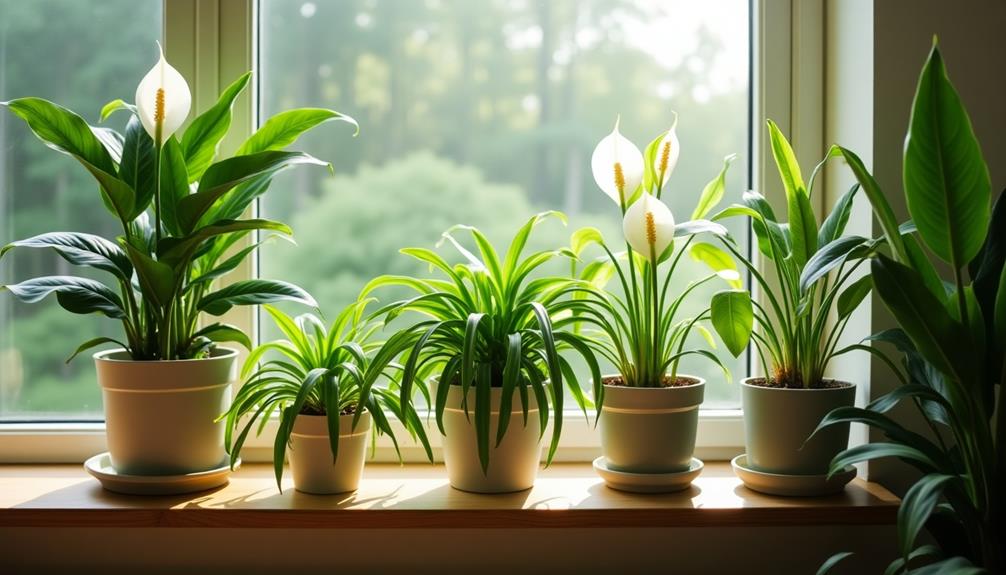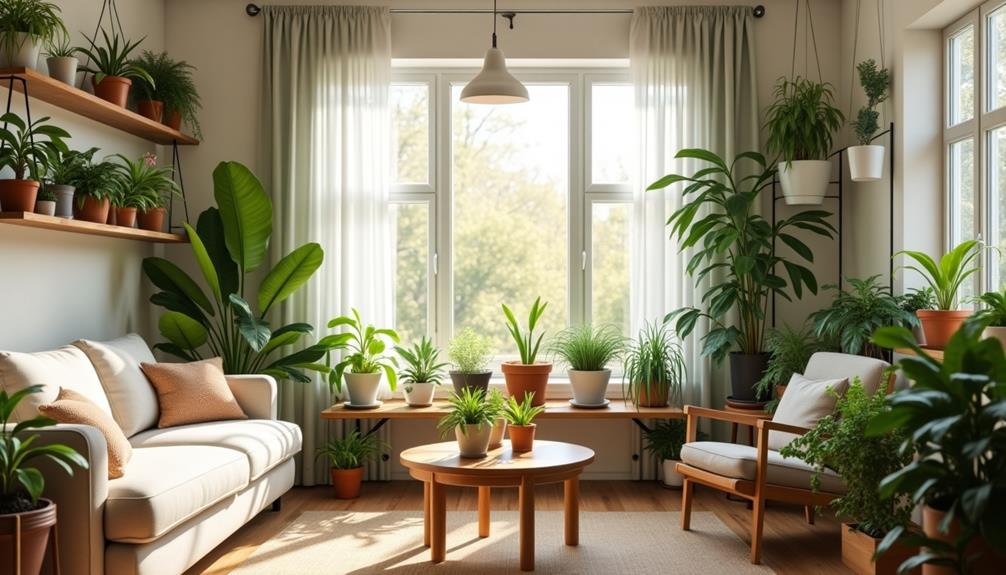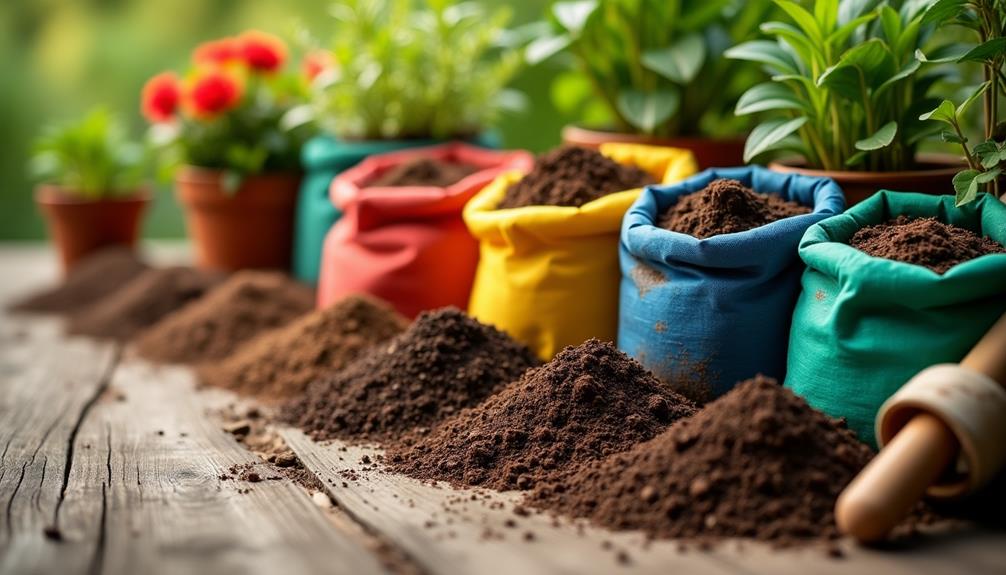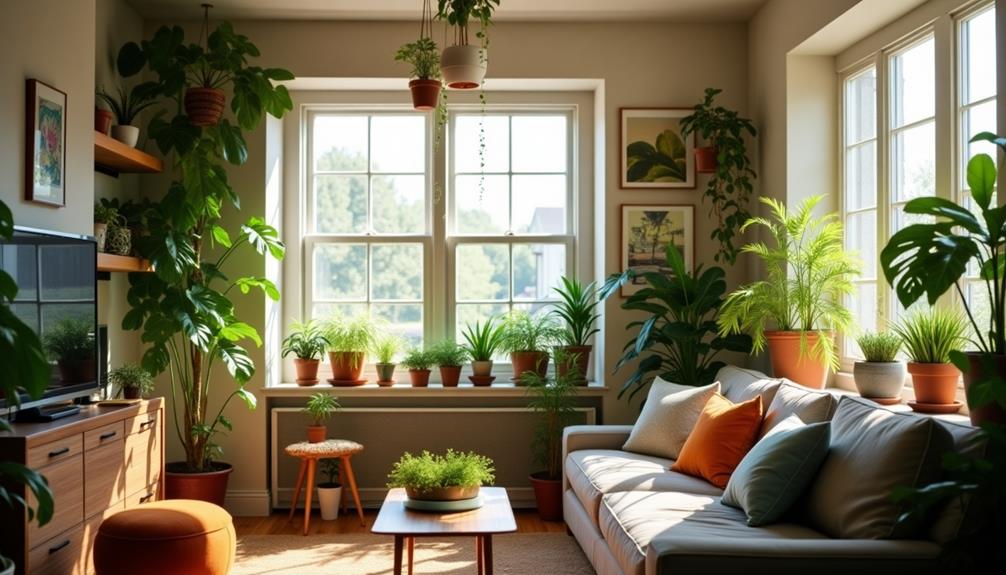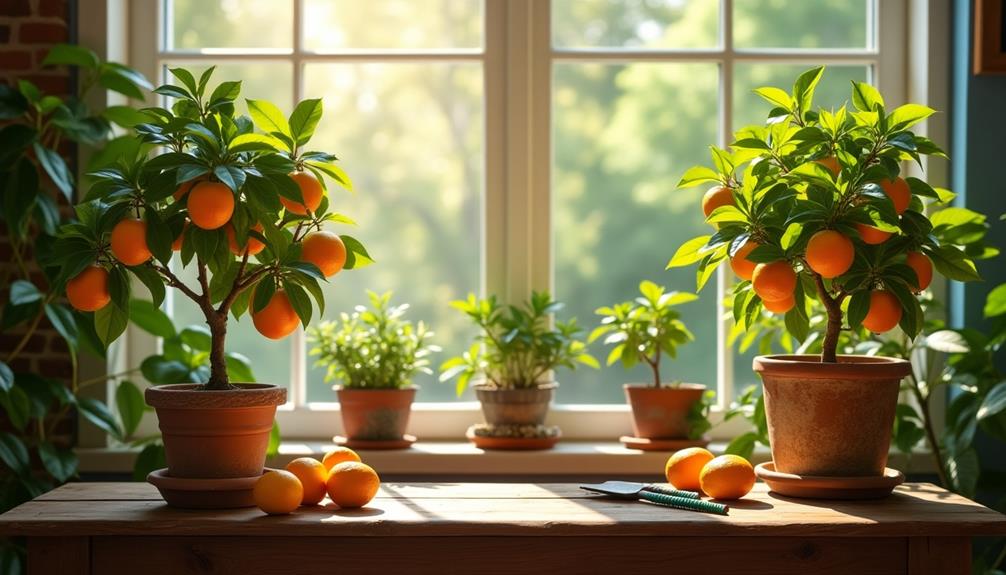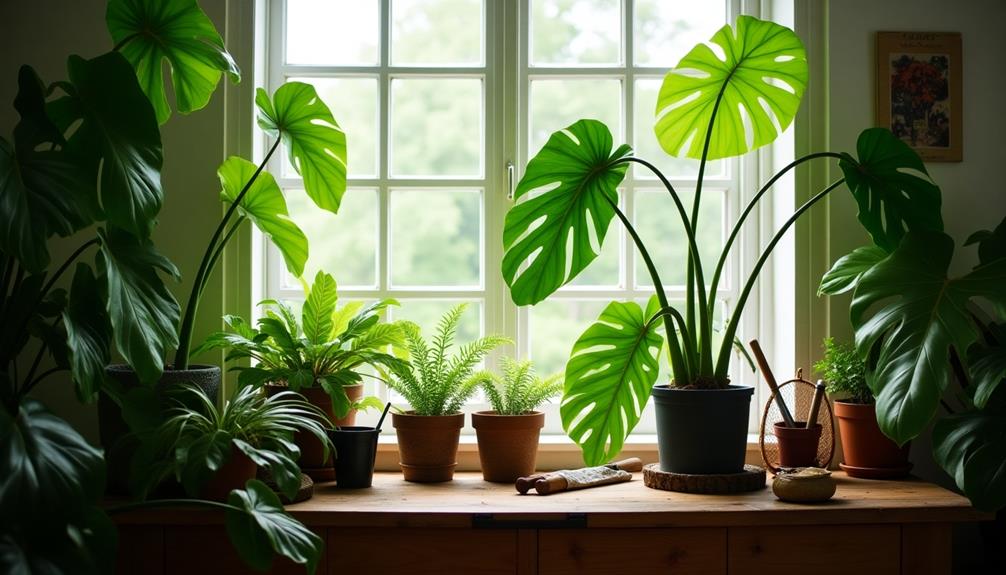When you think about improving your indoor air quality, houseplants might not be the first solution that comes to mind. However, certain varieties like the Snake Plant and Peace Lily can significantly reduce harmful pollutants while adding a touch of greenery to your space. It's fascinating how these plants not only beautify your home but also work tirelessly to purify the air you breathe. You might be wondering which specific plants are most effective or how to care for them. Let's explore some options that can enhance both your environment and well-being.
Snake Plant
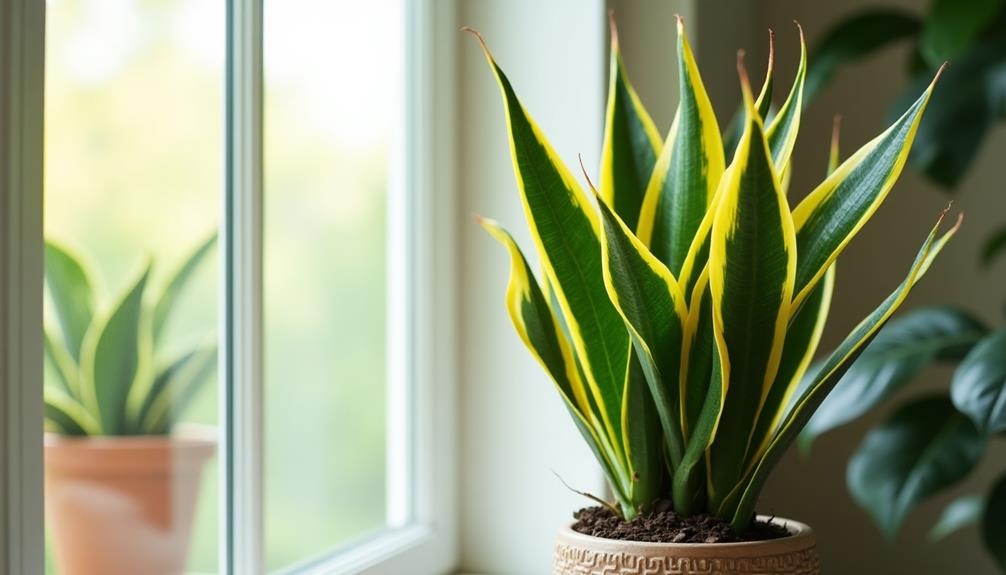
If you're looking to spruce up your living space while improving air quality, the Snake Plant is a fantastic choice. Known for its striking appearance and low maintenance requirements, it's perfect for both seasoned plant lovers and beginners.
One of the top snake plant benefits is its ability to filter toxins like formaldehyde and benzene from the air, making your home healthier.
You'll find various snake plant varieties, each offering unique shapes and colors. The most popular include the Sansevieria trifasciata, with its tall, upright leaves, and the compact Sansevieria cylindrica, which adds a modern touch.
These plants thrive in a range of light conditions and only need occasional watering, making them incredibly adaptable.
Another great aspect of the Snake Plant is its nighttime oxygen production. Unlike most plants that release carbon dioxide at night, this one continues to purify the air while you sleep, ensuring you wake up to a fresh environment.
Spider Plant
Among the most popular houseplants, the Spider Plant stands out for its ease of care and air-purifying qualities. With its arching green leaves adorned with white stripes, it adds a lively touch to any space. You'll appreciate how resilient it is, thriving in various lighting conditions, from bright indirect light to partial shade.
One of the most fascinating spider plant characteristics is its ability to produce "pups," small offshoots that can easily be propagated. If you want more of these charming plants, simply wait until the pups grow a few inches tall. You can then gently remove them from the mother plant and place them in a pot with well-draining soil.
Caring for a spider plant is simple; just water it when the top inch of soil feels dry. This low-maintenance plant also helps filter out harmful toxins like formaldehyde and xylene, making it an excellent choice for improving indoor air quality.
Peace Lily
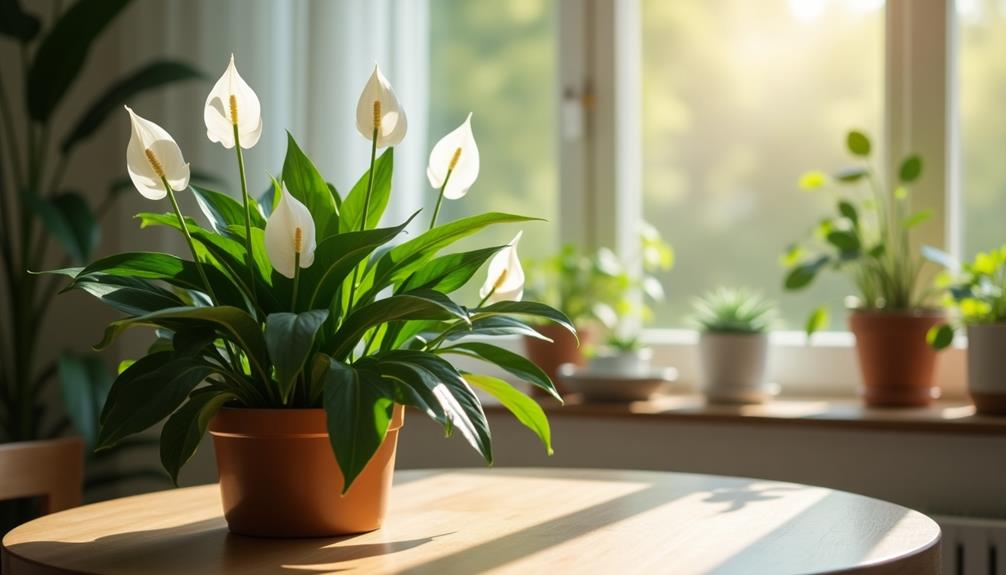
The Peace Lily is a fantastic choice for improving your indoor air quality, as it effectively filters out common toxins.
Caring for this plant is relatively easy, but you'll want to be mindful of its toxicity to pets.
Let's explore how to keep your Peace Lily thriving while ensuring a safe environment for your furry friends.
Air Purification Benefits
With its lush green leaves and stunning white blooms, the Peace Lily not only adds beauty to your space but also excels at purifying the air. This remarkable plant actively removes harmful toxins like benzene, formaldehyde, and ammonia from your indoor environment.
By incorporating a Peace Lily into your indoor gardening routine, you're investing in both aesthetics and your health.
The health benefits of having a Peace Lily extend beyond mere air purification. Studies show that cleaner air can lead to reduced headaches, improved concentration, and even better sleep quality.
When you breathe in cleaner air, you're less likely to experience respiratory issues or allergies, creating a healthier living space for you and your family.
Moreover, the Peace Lily is particularly effective in humidifying the air, which can be a great advantage in dry climates or during winter months. This natural humidification can help alleviate dry skin and respiratory discomfort.
Care and Maintenance
To ensure your Peace Lily thrives, you need to pay attention to its specific care requirements. Start with soil selection; a well-draining potting mix works best. Look for a blend that includes peat moss or coconut coir, which retains moisture while preventing root rot.
Next, focus on watering techniques. Peace Lilies prefer slightly moist soil, so check the top inch of the soil before watering. If it feels dry, give your plant a thorough drink until water drains from the bottom of the pot. Be cautious not to overwater, as this can lead to yellowing leaves or root issues.
Your Peace Lily enjoys humidity, so consider misting it regularly or placing it near a humidifier. Additionally, keep it in a spot with indirect sunlight; too much direct light can scorch the leaves.
Lastly, remove any yellowing leaves to promote healthy growth and keep your plant looking its best.
With the right soil selection and proper watering techniques, your Peace Lily will flourish and continue to purify the air in your home.
Toxicity to Pets
Peace Lilies, while beautiful and beneficial for air purification, can pose a risk to pets if ingested. These popular houseplants contain calcium oxalate crystals, which can cause irritation in your furry friends. If your pet chews on or eats any part of the Peace Lily, it might experience symptoms like drooling, vomiting, or difficulty swallowing.
To keep your pets safe, it's crucial to practice toxic plant identification. Before bringing any new plant into your home, research whether it's pet-friendly.
Fortunately, there are plenty of pet-friendly plants that can enhance your living space without endangering your furry companions. Options such as spider plants, Boston ferns, and bamboo palms offer great air purification without the risk.
If you're unsure about a plant's toxicity, consult your veterinarian or check reliable resources online. Always monitor your pets around houseplants and consider placing non-pet-friendly varieties in areas they can't access.
Boston Fern
The Boston Fern stands out as a top choice for anyone looking to improve indoor air quality. This lush, vibrant plant not only beautifies your space but also excels in filtering out harmful toxins like formaldehyde.
With various Boston fern varieties available, you can choose one that fits your aesthetic and care preferences. Popular options include the Nephrolepis exaltata, known for its delicate fronds, and the Kimberly Queen, which offers a more upright growth habit.
When it comes to Boston fern propagation, you'll find it surprisingly straightforward. You can easily propagate these ferns through division or spores.
For division, carefully separate the root ball into smaller sections, ensuring each piece has healthy roots and fronds. Plant these sections in fresh potting soil, and you'll soon have new Boston ferns thriving in your home.
Keep in mind that Boston ferns prefer high humidity and indirect light to flourish. Regular misting or placing a humidifier nearby can help maintain the moisture they crave.
With a little attention, you'll enjoy the air-purifying benefits of this stunning plant while enhancing your indoor environment.
Bamboo Palm
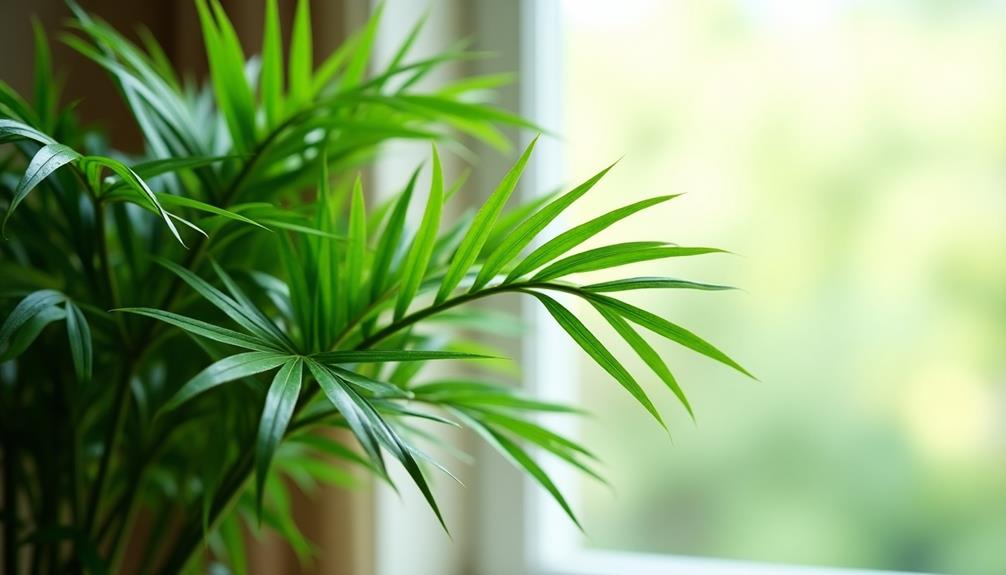
If you're looking to improve your air quality, the Bamboo Palm is a fantastic choice.
Not only does it filter harmful toxins, but it's also easy to care for with the right conditions.
Let's explore how to keep this beautiful plant thriving while reaping its air-purifying benefits.
Air Quality Benefits
How can the Bamboo Palm enhance your living space while improving air quality? This lush, tropical plant isn't just a beautiful addition to your home; it's a powerful air purifier, too.
With its ability to filter out harmful indoor pollutants like benzene, formaldehyde, and trichloroethylene, the Bamboo Palm actively contributes to a healthier living environment.
By incorporating this plant into your space, you'll notice a significant reduction in indoor pollution, which can lead to fewer allergy symptoms and respiratory issues. The Bamboo Palm's large fronds increase the surface area available for absorbing toxins, making it an efficient air-cleaning option.
Moreover, the Bamboo Palm thrives in low light, meaning you can place it in various rooms without worrying about sunlight exposure. This adaptability allows you to create a serene atmosphere while ensuring that the air you breathe is cleaner.
Care and Maintenance
Caring for a Bamboo Palm is straightforward and rewarding, ensuring your plant thrives while enhancing your living space. To maintain its health, establish a consistent watering schedule; let the top inch of soil dry out between waterings.
Bamboo Palms prefer well-draining soil types, such as a mix of potting soil and perlite or sand. Pay attention to light requirements; these palms do best in bright, indirect light but can tolerate low light conditions.
To keep your Bamboo Palm looking its best, use effective pruning techniques by trimming yellow or brown leaves as needed. This helps promote new growth and maintains its aesthetic appeal.
Humidity levels are crucial for your Bamboo Palm's well-being. Aim for a humidity level of at least 50%, and consider misting the leaves or using a humidifier if your home is dry.
Fertilization tips include feeding your plant with a balanced liquid fertilizer every 4-6 weeks during the growing season. For pest management, keep an eye out for spider mites or mealybugs. If you notice any pests, treat them promptly with insecticidal soap.
Lastly, if you want to propagate your Bamboo Palm, divide the root ball during repotting.
Ideal Growing Conditions
Providing your Bamboo Palm with ideal growing conditions is essential for its health and vitality.
First, let's talk about light requirements. Bamboo Palms thrive in bright, indirect light, so place yours near a window that filters the sunlight. Avoid direct sunlight, as it can scorch the leaves and hinder growth. If your home doesn't have enough natural light, consider using grow lights to help your plant flourish.
Next, humidity levels play a crucial role in keeping your Bamboo Palm happy. This plant loves humidity, so try to maintain a level of 50% or higher. If your home is dry, especially during winter, you might want to mist the leaves regularly or use a pebble tray filled with water to increase humidity. Grouping your Bamboo Palm with other houseplants can also elevate humidity levels.
Temperature is another factor; it prefers temperatures between 65°F and 80°F. Ensure that it's away from drafts or sudden temperature changes, which can stress the plant.
Rubber Plant
The rubber plant, with its glossy leaves and impressive height, makes a striking addition to any indoor space. Not only does it enhance your decor, but it also offers significant rubber plant benefits, such as purifying the air by removing toxins like formaldehyde. This makes it an excellent choice for bedrooms or living areas where you spend a lot of time.
Caring for a rubber plant is relatively simple. It thrives in bright, indirect sunlight but can tolerate lower light conditions, making it adaptable to various environments. Water it when the top inch of soil feels dry, and be careful not to overwater, as this can lead to root rot.
If you want to propagate your rubber plant, you can easily do so through stem cuttings. Just cut a healthy stem below a leaf node, let it dry for a few hours to form a callus, and then place it in water or soil.
With the right care, you'll soon have new plants to enjoy or share with friends. So go ahead, bring home a rubber plant and enjoy its beauty and air-purifying qualities!
Aloe Vera
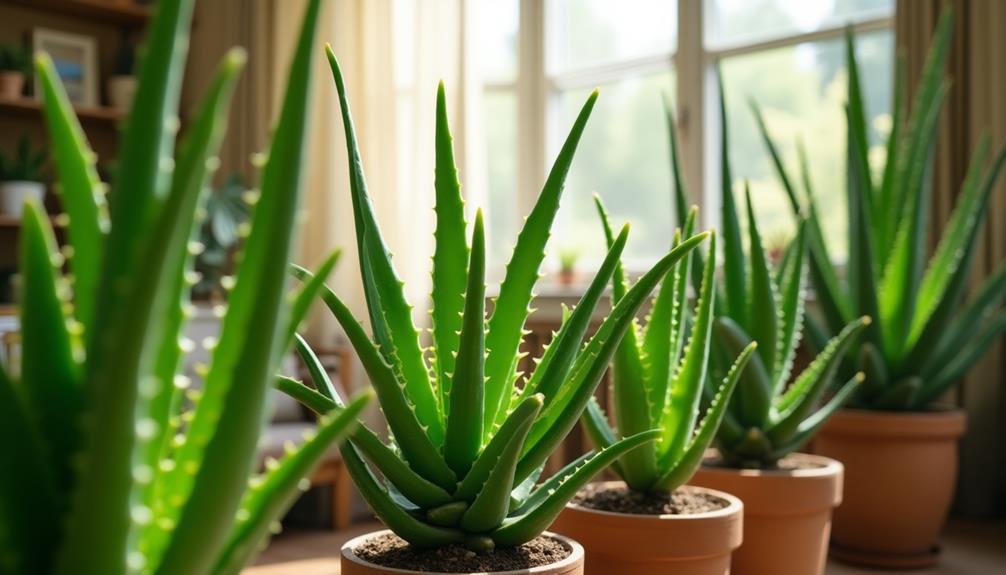
Aloe Vera is one of the most popular houseplants, known for its striking succulent leaves and impressive air-purifying properties.
You'll appreciate how easy it's to care for this hardy plant while enjoying its many aloe vera benefits. It thrives in bright, indirect light and only needs watering every few weeks, making it perfect for busy lifestyles.
One of the standout aloe vera uses is its ability to filter out harmful chemicals from the air, such as formaldehyde and benzene. This means you can breathe easier in your home, especially if you're sensitive to indoor pollutants.
Plus, it releases oxygen at night, which can improve your sleep quality.
Beyond air purification, aloe vera is famous for its soothing gel, which you can apply to minor burns and skin irritations.
This makes it a dual-purpose plant, enhancing both your indoor environment and your skincare routine.
Pothos
Known for its vibrant, trailing vines, Pothos is a top choice for those looking to enhance their indoor air quality. This hardy plant isn't just beautiful; it's incredibly effective at filtering out indoor pollutants like formaldehyde and benzene. Caring for your Pothos is easy, making it perfect for both beginners and seasoned plant enthusiasts.
When it comes to pothos propagation techniques, you can grow new plants from cuttings. Simply snip a few healthy stems just below a node, place them in water, and watch as roots develop. Once they're a few inches long, transfer them to soil for a lush new addition to your space.
However, keep an eye out for pothos leaf discoloration. If you notice yellowing leaves, it might indicate overwatering or insufficient light. Adjusting your care routine can help restore your plant's health.
Regularly dusting the leaves can also improve photosynthesis and overall vigor.
With minimal effort, your Pothos will thrive and purify the air, contributing to a healthier indoor environment. So go ahead, add this versatile plant to your collection!
Dracaena
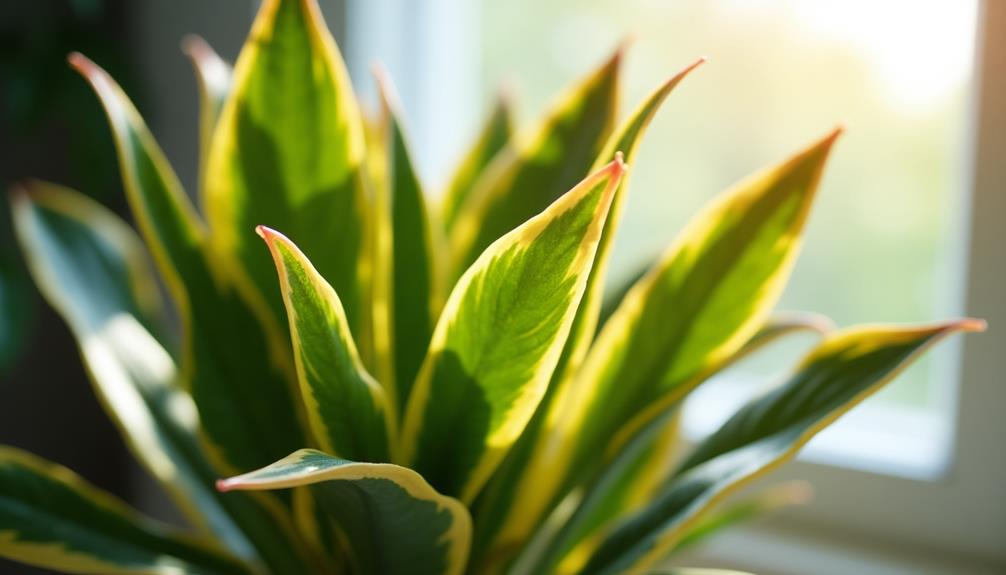
Dracaena comes in several stunning varieties, making it a popular choice for those wanting to improve indoor air quality. These plants, like the Dracaena marginata and Dracaena fragrans, aren't only visually appealing but also effective at filtering harmful toxins from the air.
You'll love how easy they're to care for, adding a touch of elegance to your home or workspace.
When it comes to dracaena placement, consider finding a spot with indirect sunlight, as they thrive in bright, filtered light. Avoid direct sunlight, which can scorch their leaves. A corner of your living room or a well-lit office can be ideal.
Ensure the pot has proper drainage to prevent waterlogging, as dracaenas prefer to dry out between waterings.
Regularly dust the leaves to help them breathe better, and occasionally rotate the plant to encourage even growth.
With the right care and placement, your dracaena varieties will flourish, enhancing your space while purifying the air.
ZZ Plant
The ZZ plant is a fantastic choice for anyone looking to improve indoor air quality.
It's low-maintenance and thrives in various conditions, making it perfect for busy lifestyles.
Let's explore its air purification benefits, care tips, and ideal growing conditions.
Air Purification Benefits
Air purification is a key advantage of the ZZ plant, making it a popular choice for indoor spaces. When you add this resilient houseplant to your home, you're not just enhancing your decor; you're actively improving your air quality.
The ZZ plant is known for its ability to filter out harmful toxins like xylene, toluene, and benzene, which can accumulate in your indoor environment. By doing this, it helps create a healthier atmosphere for you and your family. Improved air quality can lead to better overall well-being, reducing symptoms such as headaches, fatigue, and respiratory issues that may arise from poor indoor air.
Plus, the ZZ plant's low-maintenance nature means you can enjoy these benefits without a lot of effort. Incorporating a ZZ plant into your space is a simple way to enhance your indoor environment while also reaping the rewards of cleaner air.
Its striking appearance and air-purifying properties make it a perfect fit for any room. So, whether you're working from home or unwinding in your living space, the ZZ plant can be a valuable ally in promoting a healthier atmosphere.
Care and Maintenance
Caring for your ZZ plant is surprisingly easy, making it a favorite among busy plant enthusiasts. One of the most important aspects of care is soil selection. Use a well-draining potting mix, ideally one that contains perlite or sand to promote drainage. This helps prevent root rot, which ZZ plants are particularly sensitive to.
When it comes to watering techniques, less is more. ZZ plants thrive on neglect, so only water your plant when the top inch of soil feels dry. Depending on your environment, this might mean watering every two to four weeks. Be careful not to overwater, as ZZ plants store water in their thick stems, allowing them to survive longer periods without moisture.
If you notice the leaves turning yellow, it's a sign you might be watering too frequently. On the other hand, if the leaves start to shrivel, it's time to give your plant a good drink.
Additionally, providing bright, indirect light will help your ZZ plant flourish, but it can also adapt to lower light conditions. Regularly check for pests, and your ZZ plant will thrive with minimal effort.
Ideal Growing Conditions
For optimal growth, ZZ plants thrive in warm temperatures ranging from 65 to 75 degrees Fahrenheit.
These hardy plants do well in various lighting conditions, but they prefer bright, indirect light. While they can tolerate low light, too little can slow their growth. Avoid placing them in direct sunlight, as this can scorch their leaves.
When it comes to humidity levels, ZZ plants are quite adaptable. They can handle low humidity, making them perfect for indoor environments.
However, if your home has very dry air, especially in winter, consider misting the leaves occasionally or placing a humidity tray nearby to help maintain moisture.
Water your ZZ plant only when the soil is dry to the touch, which typically happens every two to three weeks.
Overwatering can lead to root rot, so it's better to err on the side of caution.
With the right temperature, lighting requirements, and humidity levels, your ZZ plant will flourish, providing you with clean air and a touch of greenery in your space.

